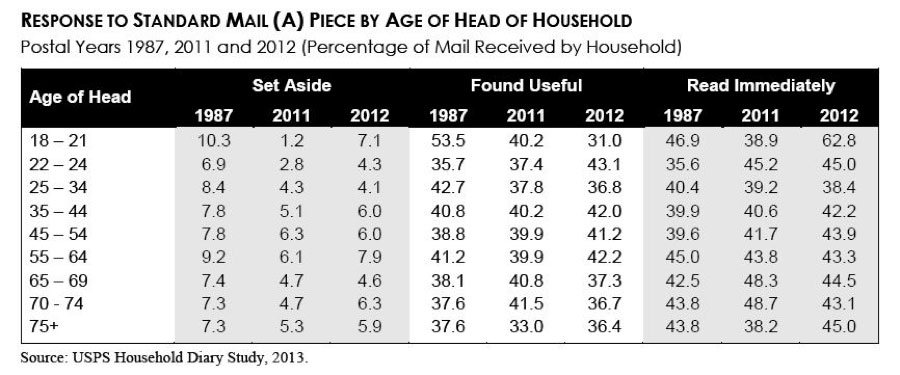By Laurie B. Beasley, President, Beasley Direct Marketing, Inc.
The new “DMA 2014 Statistical Fact Book“ is out, and its chock-full of fascinating new statistics on direct mail advertising. My conclusion: Direct mail….it’s back!
Direct mail fans may yearn for the good old days, pre-Internet, of magnificent Time-Life publication packs, coffee tables groaning under the weight of catalogs and brilliantly written subscription mail. However, the fact is that this oldest of direct response media is enjoying a renaissance.
Higher Income Households “Will Read” Direct Mail
It may be true that response rates are not as high as in that Golden Era—but in most categories they’re down only slightly, if at all. The “DMA 2014 Statistical Fact Book” reveals some marketers, such as retailers, are seeing dramatically higher response to their direct mail than in the 1980s.1 Another bright spot is higher income households, those earning $65K per year or more. Their “find it useful”, “will read” and “will respond” evaluations are up virtually across the board compared to 1987, according to household diaries.2
Savvy direct marketers are taking advantage of these trends. The “DMA Statistical Fact Book” also reveals quantities mailed in most sectors have increased year after year since the recession ended in late 2009.3 (See Figure 1 for details by sector.) However, the direct mail that’s going out today is very different from the generic mail of the past. New production, personalization and formatting options make it much more interesting and relevant to the recipient.
Figure 1: Direct Mail Volume By Sectors.
Source: DMA “2014 Statistical Fact Book” and Mintel
Debunking Direct Mail Myths
As direct mail becomes more targeted and efficient, the myth this medium is “expensive” is debunked. To a modern marketer weaned on email and pay-per-click, direct mail postage and printing costs may seem high. You wonder how can you possibly make that investment back in results—but statistics say you will. Sophisticated marketers look past raw numbers to the ultimate cost per order or per lead—that’s what really counts.
We’ve found that CPO/CPL costs for direct mail are in line with print and pay-per-click: not all that much more than email, and significantly less than telemarketing.4 (It’s not that the days of other media are over. But as online and email audiences become saturated, the cost of an incremental lead or sale is higher and direct mail once again becomes appealing.)
Direct mail is also the most trackable and measurable of all media, boosting the quality of analytics for the campaign overall, and these metrics continue to evolve. Today’s multichannel marketer knows when mail is arriving and when people are reading and responding, and uses this knowledge to turn on the tap for such other touch points as telemarketing. Thus direct mail benefits other media and boosts the overall effectiveness of the campaign.
Young Adults, 24 Years and Younger, are Among the Most Direct Mail Responsive
Finally, people like to get mail. They enjoy the experience going to the mailbox and finding something interesting to look at and hold in their hands. (They may not like to get bills, but those are increasingly processed online without ever going in the mail.) An encouraging sign for direct mail marketers is that very young adults, 24 and younger, are among the most mail-responsive groups today.5 Figure 2 provides details by age group.
Figure 2: Response to Standard Mail By Age of Head of Household.
Source: “DMA 2014 Statistical Fact Book” and USPS Household Diary Study 2013.
To sum up, direct mail is back—unless you believe, like many of us, that with all its advantages for marketers, direct mail never went away.
Learn More About Optimizing Your Direct Mail Advertising Programs
To find out more about how to optimize your direct mail programs, you can access a new guide written by Laurie Beasley. Whether you are an experienced direct mail marketer or one of the increasing number of e-only marketers who have never used direct mail, this guide contains useful suggestions and best practices to optimize your direct mail campaigns. Access 10 Ways to Optimize Your Direct Mail Campaigns now.
Find out more about the Direct Marketing Association here. Order The DMA 2014 Statistical Fact Book here.
* * * *
About the Author, Laurie B. Beasley
 LAURIE B. BEASLEY is co-founder and president of Beasley Direct Marketing, Inc. www.BeasleyDirect.com, a Silicon Valley direct marketing agency that has managed search, email, online, direct mail, and demand generation campaigns for over a hundred companies. Ms. Beasley serves as president of the Direct Marketing Association of Northern California DMAnc.org. She manages the Online Roundtable for the BMA Northern California www.NorCalBMA.org. She is an instructor of online marketing at UC Berkeley Extension and teaches in the Level 2 Certification program for the Online Marketing Institute www.onlinemarketinginstitute.org . She frequently speaks on online marketing and demand generation topics for marketing organizations, including the Online Marketing Summit, Interactive Marketing Week, DMA Annual Conference, and the Marketing Executive Networking Group.
LAURIE B. BEASLEY is co-founder and president of Beasley Direct Marketing, Inc. www.BeasleyDirect.com, a Silicon Valley direct marketing agency that has managed search, email, online, direct mail, and demand generation campaigns for over a hundred companies. Ms. Beasley serves as president of the Direct Marketing Association of Northern California DMAnc.org. She manages the Online Roundtable for the BMA Northern California www.NorCalBMA.org. She is an instructor of online marketing at UC Berkeley Extension and teaches in the Level 2 Certification program for the Online Marketing Institute www.onlinemarketinginstitute.org . She frequently speaks on online marketing and demand generation topics for marketing organizations, including the Online Marketing Summit, Interactive Marketing Week, DMA Annual Conference, and the Marketing Executive Networking Group.
About Beasley Direct and Online Marketing
Beasley Direct and Online Marketing, Inc. www.BeasleyDirect.com, is a full service Silicon Valley direct marketing agency that has managed search, email, online, and demand generation campaigns for nearly a hundred companies. The company provides multi-channel campaigns for B2B and B2C. Clients include SAP, Rovi, Safeway.com, Omnicell, Apple, and more.
Direct Marketing Association of Northern California DMAnc.org is an educational and networking organization that meets monthly for educational topics and workshops. We offer an on-site certificate in online marketing workshop series in conjunction with the Online Marketing Institute.
1. The DMA 2014 Statistical Fact Book, RESPONSE RATES TO STANDARD MAIL (A) ADVERTISING SOLICITATIONS, p. 60 and RESPONSE RATES TO FIRST-CLASS ADVERTISING SOLICITATIONS, p. 61.
2. The DMA 2014 Statistical Fact Book ,RESPONSE TO STANDARD MAIL (A) PIECES BY INCOME, p. 65.
3. The DMA 2014 Statistical Fact Book , DIRECT MAIL VOLUME BY SECTORS, 2008–2013, Source: Mintel, p. 78.
4. “Direct Marketing Association 2010 Response Rate Report”; no more recent information available.
5. “The DMA 2014 Statistical Fact Book,” RESPONSE TO STANDARD MAIL (A) PIECE BY AGE OF HEAD OF HOUSEHOLD, p. 69.





Wow – that was impressive and encouraging. Thanks for sharing your authoritative opinion, practical hints. I will definitely follow your updates…
SEO Consultants